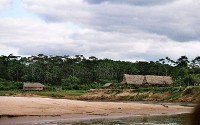The project which is situated at the Université Paris X – Nanterre (France) and at the Max Planck Institute for Evolutionary Anthropology in Leipzig (Germany) aims at building up a comprehensive documentation of the Cashinahua language and culture at its current stage in Peru and – to a lesser extent – in Brazil.
Such a documentation offers the possibility for further research – by linguists and anthropologists as well as by members of the ethnic community themselves – when language and culture are extinct, and may presently be seen as a contribution to the efforts of the respective Cashinahua communities and associations in both countries to preserve and fortify their language and culture. In addition, the annotated texts in the archive as well as the reappraisal of a corpus of historical and mythological texts assembled one hundred years ago by Capistrano de Abreu – another declared aim of the project – may be a basis for monolingual teaching material used by Cashinahua teachers in the village schools. Apart from the fact that the documentation will give an idea about Cashinahua way of life to a general public, different data – including older material collected by Camargo and other researchers (esp. in Peru) – and analyses will be brought together in the archive so that the Cashinahua themselves (via internet from their associations in Brazilian and Peruvian towns) may have access to these.
The type of material to be included in the archive ranges from texts recorded on video and/or audio over photos and drawings to research results (e.g. phonological structure, sketch grammar, sociolinguistic data).
The data corpus contains texts from different genres, whereby in addition to the recording there will be a phonemic transcription and translation at least into both national vernaculars (Spanish/ Portuguese) and possibly also into English (as a requirement for minimal annotation, with ELAN time linking). Cultural data on everyday activities as well as ritual ceremonies and feasts will be included, too. The latter, according to the Cashinahua participants of the 2006 workshop in Praia do Carapanã, is of major interest to the communities of Cashinahua seringueiros who want to revitalize their cultural tradition and fully understand its significance.
A lexical database (partially from the recorded text material) with both existing orthographies and the phonemic orthography used by the researchers will be set up, thus also offering the possibility for orthographic discussion and standardization across national borders.
The project wants to encourage the active participation of Cashinahua community members, not only as consultants but also with regard to the recording and analysis/ annotation of data, in order to fully take over the documentation once the project is finished.
The documentation for the Dobes archive will basically be carried out in Peru, predominantly in the village of San Martin, for various reasons:
- In Peru, as was mentioned before, the Cashinahua language and culture could be preserved to a higher degree due to more isolation in comparison with most Cashinahua areas in Brazil. Most of the inhabitants of San Martin, a relatively recent settlement which is only about 3 hours by boat from the town of Puerto Esperanza, have come downriver from a more remote area (Balta, 3 to 5 days from Puerto Esperanza) and speak a variety of the language which does not show many features induced by contact. There are also various older inhabitants of San Martin who have specific skills (story-telling, cultural memory, handicrafts).
- The village has got a good infrastructure (solar energy), apart from not being far from town so that the project members do not lose their time traveling for days on the river.
- The community has proposed to construct a house for the project members to stay during field work which at the same time can serve as a kind of library/ documentation centre to store the documented material (CDs and audio cassettes as a common format) which may be used by other Cashinahua living up- and downriver, too, in addition to the internet archive which will only be accessible in Puerto Esperanza.
Bibliography by Philippe Erikson: kirinkobaon_kirika.pdf




